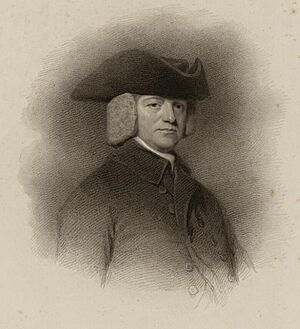Richard Watson (bishop of Llandaff) facts for kids
Richard Watson (1737–1816) was an important English church leader and scholar. He was a bishop in the Anglican Church, serving as the Bishop of Llandaff from 1782 until he passed away in 1816. He also wrote many influential political writings called pamphlets. In his religious studies, he was part of a group that followed the ideas of Edmund Law, which included other famous thinkers like John Hey and William Paley.
Richard Watson's Life and Education
Richard Watson was born in Heversham, a place in Westmorland (which is now part of Cumbria). He went to Heversham Grammar School and then studied at Trinity College, Cambridge. He received a special scholarship to help pay for his studies.
In 1759, he finished his studies as the Second Wrangler. This means he was the second-best student in mathematics that year. This event actually helped change how universities graded students. Before, teachers would just "judge" who was best. But after Watson's challenge for the top spot, the university started giving specific marks for each question. This new "marking" system soon became the main way to rank students based on their skills.
In 1760, Watson became a fellow at Trinity College. This meant he was a senior member of the college. He earned his master's degree (MA) in 1762. Later, in 1764, he became a Professor of Chemistry. He was also chosen to be a member of the Royal Society in 1769, after he published a paper about how salts dissolve in water.
His Church Career
Watson's career in the church began when he became the Regius Professor of Divinity at Cambridge in 1771. This was a very important teaching role in theology.
In 1773, he married Dorothy Wilson. She was related to the person who had given him his scholarship many years before. In 1774, he took on a role as a prebendary at Ely Cathedral. This meant he was a senior priest with special duties.
He continued to rise in the church. In 1779, he became the archdeacon of Ely and a rector (a main priest) in Northwold. Two years later, he moved to be the rector of Knaptoft.
In 1782, he left all his other jobs to become the Bishop of Llandaff. He held this important position until he died in 1816. In 1788, he bought a large estate called Calgarth near Windermere. In the same year, he was also made an honorary member of the American Academy of Arts and Sciences.
Richard Watson was buried at St Martin's Church in Bowness-on-Windermere.
Richard Watson's Writings and Ideas
Richard Watson was known for his writings, especially during a time of big debates about government and society.
He wrote a book called A treatise upon the authenticity of the Scriptures, and the truth of the Christian religion in 1792. But his most famous work was An Apology for the Bible in 1796. This book was written to argue against the ideas of Thomas Paine, who had written a book called The Age of Reason. Paine's book questioned many religious beliefs. Watson believed his own book helped stop people from losing their faith because of Paine's writings.
In 1798, Watson published An Address to the People of Great Britain. In this writing, he argued that people should pay more taxes to help pay for the war against France and to reduce the country's national debt (money the government owed). Another writer, Gilbert Wakefield, disagreed with Watson. Wakefield argued that it was unfair for wealthy people to have so many advantages.
Watson also gave a sermon in 1785 called 'The Wisdom and Goodness of God, in having made both Rich and Poor'. In this sermon, he said that it was God's plan for some people to be rich and others to be poor. Thomas Paine, in his book Agrarian Justice (1796), strongly disagreed with Watson. Paine wrote that God only created male and female, and gave everyone the Earth to share. He did not believe God intended for some to be very rich and others to be very poor.
Watson also wrote a book about Christian beliefs called Theological Institutes Or, A View of the Evidences, Doctrines, Morals, and Institutions of Christianity, which was published in 1830.
His own life story, called Anecdotes of the life of Richard Watson, Bishop of Landaff, was finished in 1814 and published after he died in 1817.
In the 1800s, some people thought that Richard Watson was the first person to suggest the idea of the electric telegraph. However, this was a mistake. Another scientist named William Watson (who lived from 1715 to 1787) did research on electricity, but even he was not involved in inventing the telegraph.


